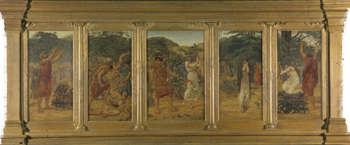A model of perfect order: the Southwark Collection
Ruskin Library - Summer exhibition until 24 September.

“The first function of a museum,” wrote John Ruskin, “is to give an example of perfect order and perfect elegance.” As an historian of art, educationalist and artist in his own right, Ruskin exerted considerable influence on the form and development of British museums and art galleries, providing a practical example in the museum of his Guild of St. George at Sheffield, opened in 1875.
He especially hoped for “a large educational museum in every district of London, freely open every day … for the use of all classes.” One of the most important fulfilments of that dream was the South London Art Gallery, appropriately close to Ruskin’s early homes. Conceived by William Rossiter in the 1860s, the gallery grew out of the South London Working Men’s College, and opened a large new building in Peckham Road in May 1891. The inlaid wooden floor, designed by Walter Crane, carries the message: “The source of art is the life of a people.” Now called the South London Gallery, it continues to be a thriving centre for exhibitions of contemporary art and educational activity.
Drawings by Ruskin form a significant part of the permanent collection (London Borough of Southwark), and these are shown here together for the first time outside London, along with the magnificent marble bust of Ruskin by H.C. Fehr, commissioned in 1901. This exhibition also includes a selection of outstanding Victorian paintings and drawings, including celebrated genre scenes by Carl Bauerle and George Smith, and work by Ford Madox Brown, Alfred Parsons, T.M. Rooke and G.F. Watts.
Open daily, Monday - Saturday 11 - 4, Sunday 1 - 4. Admission free.